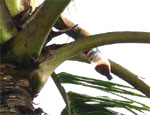
Technology Description
Sequential toddy & nut production(SCTNP) technology which producestoddy and nuts from the same spathe the palms has provided the farmers increase farm income without sacrificing the copra products and fully maximize economic potential of the palms with addition of another product which is coconut sap or toddy. It has high total sugar, ascorbic acid, phosphorus, and in amino acids, vitamins and minerals. can be an alternative source of sugar other products like sap drink (fresh cooled beverage), coco nectar (syrup) and vinegar which are high value food products.
Tapping & harvesting of toddy
Tapping is done twice a day.Harvesting of toddy can be donemorning ( taken before 8 am ) forproduction of ‘tuba’ or vinegar whilethe production of fresh sap drink, nectarand sugar, it is best to used the afternoonharvest ( taken not later than 3 pmwhich is sweeter than the morningharvest. To produce sweet toddy, it necessary that all tools and containersbe used should be clean at all times.Adding of lime to the receptacle preventsthe sap from fermentation.
Toddy processing
The conversion of toddy into sap drink,coco nectar and sugar involves a simple operation. As the coconut sap is highly perishable due to the yeast microflora, the harvested sap should be immediately processed by boiling for 1/2 hour in alarge cast iron pan. This process preventsthe sap from fermentation.
Sap Drink
This can be simply done immediately by pasteurizing (heating at 60°C) the toddy. The toddy is then poured separately in the desired container tightly sealed and placed in the refrigerator. If hygienically prepared, the sap drink can be stored until 3 days without deterioration.
Coco Nectar/Syrup
Further boiling of toddy until it reaches 110° C temperature or sticky under a moderate to very low heat. The sticky liquid shall be allowed to cool then poured into a desired container.
Coco Sugar
Boil coco sap to evaporate the water under moderate heat with occasional stirring until liquidthickens at 115°C. Remove it from the flame when it begins to become very sticky. Continue mixing until it becomes granular. Air dry the brown sugar before placing them in a packaging material.
Sap Natural/Organic Vinegar
Pour toddy in a wide large container witha clean netted cover to allow aerationand prevent entrance of dirt and foreign objects. After 5-10 days fermentation period in a well ventilated room, the sap can be harvested as vinegar. To maintain the desired quality of the matured vinegar (with at least 4% acidity),pasteurize it by boiling for 5-10 minutes at 60-65° C, allow the vinegar to cool before placing in very clean bottles and then cover tightly and sealed.
Source: Philippine Coconut Authority Website




Can you say if it is exposure to light or air that causes fermentation? Can the sap be frozen until sufficient quantities are feasible for making nectar?
Dear, Sir / Maa’m
This is Mr. Julien Roble certified coconut sugar” Trainor ( for hire )
we conduct seminars about Organic Coconut Sugar Making – Package Seminar anywhere in the Philippines
for livelihood Program for Farmers and Woman Organization
” best OPPORTUNITY ” go natural ways ” Export Products ”for abroad ”
( I would like to conduct Coconut Sugar Making Seminar Package at the following )
” LGU, PRIVATE INDIVIDUAL ,COMPANY and OTHERS” IN EASY WAY
Coconut sugar (also known as coco sugar, coconut palm sugar or coco sap sugar) is a sugar produced from the sap of cut flower buds of the coconut palm.
( Sugar made from coconut sap tuba’vinegar )
Coconut sugar comes in crystal or granule form, block or liquid. It is essentially a two-step process. It starts with harvesting or “tapping” the blossoms of a coconut tree. Farmers make a cut on the spadix and the sap starts to flow from the cut. The sap is then collected in bamboo containers. The sap collected is then transferred into giant woks and placed over moderate heat to evaporate the moisture content of the sap. The sap is translucent and is about 80% water. As the water evaporates, it starts to transform into a thick syrup-like substance known as a “toddy”. From this form, it is further reduced to crystal, block or soft paste form, or it remains in this form. Essentially, coconut sugar’s form depends on the moisture content of the toddy.
The Glycemic Index of coconut sugar is 35 and is classified as a low glycemic index food. It is considered to be healthier than refined white sugar(60) and brown sugar(64).[citation needed] It can be used as a 1:1 sugar substitute for coffee, tea, baking, and cooking.
Im looking your strong Positive reply,
Mr. Julien Roble – Cebu / Cagayan de Oro City
Certified Coconut Sugar Trainer
Contact no: + 63 947 459 9822
0905 – 853 – 97 84
email: [email protected]
hi guys. i really need help regarding our feasibility study. I chose coconut sugar as my topic, it seems very interesting. but im having a hard time to polish my work. if ever I could have the copy of feasibility study of coconut sugar, it would be a very big help guys. so please. HELP lang po..
elow poh.., about don sa banana peel vinegar pwede po ba talaga yon? how many days naman po para magamit na ang viegar?
Pau: coconut sap should be processed immediately to sugar after harvesting, if you want to make sugar. 3-6 hours. or you can visit http://www.cocowonder.multiply.com
good eve sir,
can you post the nutrient contents of toddy?? tnx
I want to buy the coco nectar for export. what is the life span of the sap in its natural form not fermented. Is there a factory producing now the coco nectar and already packed in tin cans or tetra packs. This is what I’m looking for…
Pau Gelig,
This is available nationwide. Luzon, Visayas, and predominantly Mindanao.
You can see them anywhere in the Philippines. What would you be interested in the sap gathering? Please inform.
I’m very interested in the sap gathering and would like to know if there are people doing this already and where can we see the actual gathering.
RoP = GRP = Republic of the Philippines.
@Paul
That sounds interesting. Please drop me an email me for details.
ROP= Republic of Philipines
Dear Romy K & Manuel,
Can you give me the contacts detail of coconut toddy communities in ROP, so i can make contact with them.
Im very interested to import toddy drinks with 5% alcohol content from your country since ROP has plentiful of coconut plantations and many government bodies in helping to boost the coconut industry.
Thank you,
Paul Woon
+65-91626127
@ Paul Woon
What is ROP?
Hi Manuel,
Re: Coconut Toddy.
Laguna and Quezon has a lot of coconut toddy community in the south of Luzon,
(an aggrupation of mangangret) (Visayas and Mindanao is managete)
Do you have information on the other coconut toddy community in the Philippines? In Bicol? in Visayas? In Mindanao?
I’m curious. Thanks
gusto ko po sanang malaman tungkol doon s vegetable farming n kunting space lang ang kailangan pra makapagtanim at may machine n ginagamit pra madiligan yung mga tanim
@jewel
everything’s listed on this page. what else are you looking for?
Hi, i want to request for the list of raw materials needed for coconut sap or toddy. really need it. and also the equipments or tools used. thanks n_n
need for our research.
Sir/Madam,
I am BS industrial engineering fourth year student in Liceo de Cagayan University, and i currently conducted a research study now about the quality standards and quality management in coconut vinegar production as part of our requirement of the subject. can u pls help me about the matter of quality standards and management in manufacturing this coconut vinegar.
I hope that i can hear you soon and help me in this research…. Thank you so much in advance……
Bryan, 09262023029
@Bryan Guligado
I’m sorry but my knowledge is very limited on processing coconut sap. You can contact the Philippine Coconut Authority about the quality standards. Thanks for your comment.
Hallo
I have been following up the process of value chain in coconut products in the internet ,specifically on Wine and would like you help me with notes or instruction for making the same for bottling.Kindly help me.
SAMMY GATERE
Hi
Send me detailed notes on Coconut Wine processing,Soap making,and banana peel vinegar preparation;DIY Manual.
SAMMY,Mombasa-Kenya
PAUL, gREETINGS!!
iVE JUST ATTENDED A REGIONAL INVESTMENT FUROM AT GENSAN LAST WEEK AND THE PROJECT THAT INTREST ME MOST IS THE COCO SUGAR PROCESSING. RECENTLY I’M ON A MOSCUVADO PROCESSING RYT NOW BUT JUST ONLY FOR OFF MILLING SESSON .GOT YOUR EMAIL @ THE PACCRD MAILS AND I ‘M SURE YOU CAN BE OF GREAT HELP TO THIS VENTURE. JUST WANT TO INQUIRE IF HOW COULD I AVAIL OF YOUR FEASIBILITY STUDY REGARDING COCO SUGAR PROCESSING.
RECENTLY I HAVE A 5 HECTARE DWARF TACONAN BREED GREEN IN COLLOR AND ALMOST 8O% OF THE HILLS ARE NOW ON ITS BEARING STAGE THATS WHY EXCITED AKONG MAKA PAG VENTURE INTO THIS PROJECT.. ANTICIPATING YOUR HUMBLE RESPOND ON THIS REGARD. THANK YOU & GOD BLESS!!
Jess S.Lebanan
172 AURORA Q.ST.
KORONADAL CITY,SO.COT
TEL.NO.O83 2283962
cell no.09215604870
Paul
Really depends on your location and exact requirements (ie what product do you want it for). Fresh toddy is highly perishable, and if you don’t want any additive of any kind, it has to be processed on site.
Dear Sir,
Can you provide me information of any toddy supplier in ROP.
Thank you,
Paul Woon
i want to make tungog but i dont know how…..coz my father he’s a manananggot….tungog in cebu very expensive
i know tungog from mangrove bark….but i wnat to learn
Hi Carla,
Just search this blog because i have a post regarding how to make detergent powder.
hi..ur show is great!!
can i have the ingredients of detergent powder?
thanks and more power
maaari ko po ba itanong kung paano kayo makokontak?
Ground mangrove bark (aka tungong / tangal) is sometimes placed in the drip collection vessel attached to the spathe itself or in larger collection vessels, after the sap has been collected from the trees.
This practice varies from place to place. In some places, tangal is not used at all.
How much tangal? No fixed rule. It depends on the winemaker, or the preference of the customer.
How do farmers apply tungog? by directly mixing with coconut sap? or by disinfecting the coconut sap tap? how much if mixing? tease poon?
thanks,
student researcher
Sorry, typo error.
The common local practice for inhibiting fermentation is the use of MANGROVE barks (Tagalog:tangal or Bisayan:tungog). Also used but not popular is the use of crushed chiles or ginger.
Pasteurization is achievable below 100°C – the boiling point of water. The 600°C you posted is too much, and probably not achievable in kitchen conditions.